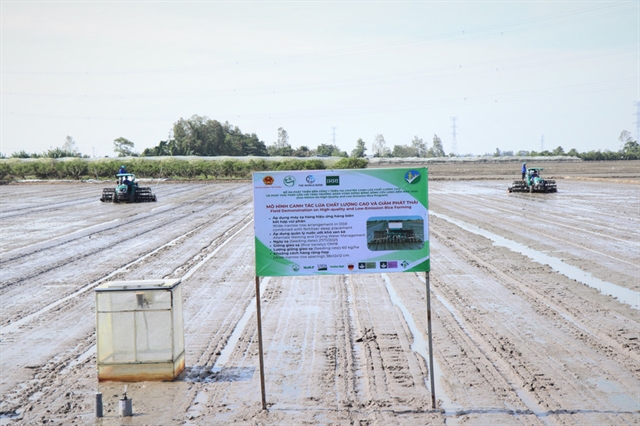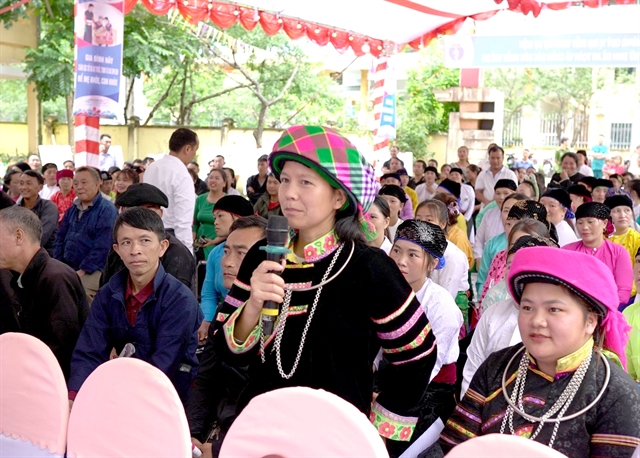 Society
Society

 |
| Women from ethnic groups in Hà Giang Province took part in a 2024 public campaign promoting safe childbirth and better child healthcare. — VNA/VNS Photos |
HÀ NỘI — For more than six decades, population work in Việt Nam has been recognised as a top strategic priority, closely tied to the nation's sustainable development.
Now, as Việt Nam grapples with profound demographic shifts, the country is preparing to take a major legislative leap with the formulation of its first-ever Population Law.
This proposed legislation, currently in draft form, represents a critical transition. No longer solely focused on family planning, the country is shifting towards a vision of population and development, a policy evolution designed to seize demographic advantages and proactively address looming challenges.
Foundation for sustainable growth
Over recent years, Việt Nam has made considerable progress in the field of its citizens. These achievements have helped boost per capita income, fuel economic growth, advance gender equality, protect the environment, and improve social welfare.
The country successfully met the Millennium Development Goals by 2015 and is now steadily progressing towards the United Nations’ 2030 Sustainable Development Agenda.
These gains have laid the groundwork for Việt Nam’s pivot from a narrow focus on family planning, to a holistic approach to population and development.
With a population of over 100 million people, Việt Nam has been in a period of golden population structure since 2007. This is characterised by a large proportion of people of working age, a demographic window of opportunity for socio-economic development.
However, experts warn that this window will not remain open indefinitely. Without the right policies in place, this demographic dividend could quickly turn into a liability as the population ages and the labour force shrinks.
While Việt Nam has maintained a replacement fertility rate around 2.1 children per woman since 2006, recent data suggests this rate is now on the decline.
By 2024, the national average had dropped to 1.91, the lowest in the country’s recorded history. This trend is particularly pronounced in major economic regions like the southeast and the Mekong Delta, where fertility rates have plummeted to between 1.48 and 1.62 children per woman.
Conversely, more disadvantaged regions, such as the northern midlands and mountainous areas, continue to experience above-replacement fertility rates, reaching 2.34.
This severe regional imbalance in fertility and population structure is a growing concern. It threatens to worsen inequalities, strain public services and hinder national cohesion and sustainable development.
Experts warn that if current trends persist, Việt Nam could exit its golden population period as early as 2039. This would trigger a chain of consequences, including labour shortages, increased social welfare burdens, imbalances in the insurance system and under use of the existing social infrastructure.
A legislative milestone
Deputy Director General of the General Office for Population and Family Planning, Dr Phạm Vũ Hoàng, said that Việt Nam’s population policy now faces a host of challenges, including falling fertility rates, regional disparities, persistent gender imbalance at birth, rapid ageing, slow improvement in population quality and ineffective migration management.
In response, the Ministry of Health is leading efforts to draft the country’s first Population Law, a strategic and legislative upgrade from the 2003 Population Ordinance, which remains the existing legal framework. This move enhances the legal status of population policy and reflects its vital role in national development strategy.
Deputy Minister of Health, Associate Professor Dr Nguyễn Thị Liên Hương, emphasised the pressing need for this legislative step, noting that the new law is intended to give legal form to the Party’s strategic directions on population. It will also lay the groundwork for addressing population ageing while making the most of Việt Nam’s golden population structure.
She said the goal is to ensure that, by 2045, Việt Nam becomes a country with high-quality human resources, a strong labour force, and is a high-income economy, thereby raising the nation’s profile on the global stage.
The draft Population Law is built around three key pillars aimed at addressing Việt Nam’s evolving demographic landscape.
First, it seeks to maintain replacement-level fertility across the country through tailored strategies that reflect the unique characteristics of each region and population group. This approach is designed to prevent demographic imbalances and lessen the impact of population ageing, helping to secure a sustainable workforce in the years ahead.
Second, the draft prioritises improving population quality from birth. Proposed measures include universal access to pre-marital counselling, broader prenatal and newborn screening, and stronger efforts to prevent genetic disorders and birth defects. It also calls for better nutrition, mental health support and early childhood development to ensure a healthier, more resilient population from the outset.
Third, the law outlines policies to help the country adapt to a rapidly ageing population. These include safeguarding social security and healthcare access for older citizens. One notable proposal is to provide health insurance to elderly people who are currently uninsured, a proactive measure aimed at reducing the future burden on the healthcare and social insurance systems.
 |
| Health workers at the Từ Dũ Obstetrics Hospital in HCM City care for newborn babies. |
A landmark shift in the draft law is its departure from the traditional mindset of controlling population growth. Instead, it embraces a vision of population as a development driver. Rather than strictly limiting the number of children per family, the law seeks to promote reasonable fertility based on individual choice and socio-economic conditions.
For the first time, couples would be legally empowered to decide freely on the number and timing of their children, a dramatic departure from past rigid controls. This reflects a respect for personal autonomy and acknowledges the diverse aspirations of modern Vietnamese families.
Supporting this shift is a recent policy change by the Party’s Central Inspection Commission. From March 20 this year, Party members who have a third child will no longer face disciplinary action, a move hailed by Professor Nguyễn Đình Cử, former Director of the Institute for Population and Social Affairs, as both timely and necessary.
He noted that in light of declining fertility rates, particularly in urban areas, the change would help slow the downward trend and create a foundation for future regulatory reforms.
Incentives and social support
To address low fertility in key areas such as industrial zones and large cities, the draft law introduces a notable incentive that gives women with two children priority access to social housing. This policy is designed to both encourage childbearing and support young families in balancing work and parenting responsibilities.
In a further show of support for the elderly, the draft proposes state-purchased health insurance for those without coverage, ensuring equitable access to healthcare and improved quality of life in old age.
The law also introduces stronger administrative penalties for violations in the population sector, reinforcing legal compliance and public awareness.
Việt Nam stands at a critical demographic turning point. For the first time, population dynamics are shaping nearly every aspect of national life, from economic growth and healthcare to education, security and political stability.
As the country faces major shifts such as ageing, falling fertility, gender imbalances and changing migration patterns, the need for a modern, flexible legal framework has become urgent.
A recent Ministry of Justice review affirms that the draft Population Law introduces breakthrough measures absent from current legislation, directly targeting the country’s most pressing demographic challenges.
Population is no longer just a figure — it is a strategic asset central to Việt Nam’s global competitiveness. This law is not merely a policy tool, but a roadmap for unlocking the nation’s demographic potential and building a high-income, digitally-driven economy by 2045. — VNS




